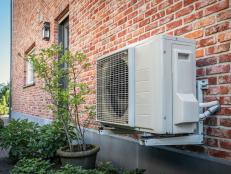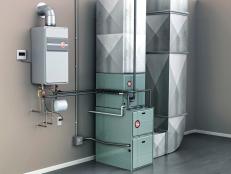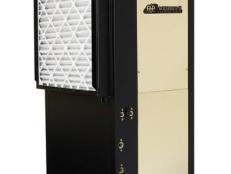Stopping Air Leaks in HVAC Systems
Many studies have shown that energy losses in heating/cooling ducts in most homes can run 25 percent to 30 percent — or more. The majority of these losses can be traced to air leaks in the equipment or ductwork that can easily be found and repaired. Although typical costs for remediation run $350 and up, the savings will usually be recouped within just the first year.
Finding air leaks can be time-consuming, but there are some tricks that will not only speed up the job but make the inspection much more accurate. One is the use of a blower door test: A large fan at the front door will pull air out of an otherwise closed-up house, creating drafts from leaks that are much easier to detect than the typical slow infiltration of air. (The blower door also reveals any leaks in the building envelope itself.)
Another tool called a duct leakage detector or a flow hood blows air into the duct system through a register after all other returns and registers have been sealed. With both tools, special instruments indicate any differences in pressure or where air leaks occur.
Here's a list of what you'll need to repair such leaks in your customers' HVAC systems:
Materials and Tools:
- battery-operated drill gun, drill bits and magnetic hex-head screwdriver bits
- ladder
- flashlight
- fool for installing duct zip ties tightly
- sheet metal screws (hex head)
- duct zip ties (for flex duct)
- duct mastic and brush
- tape mastic (aluminum tape with 15-mil butyl backing; can be used in areas up to 200 degrees F)
Equipment Air Leaks
Leaks From Duct Damage
- Metal ducts or flex ducts that aren't properly secured with screws or duct zip ties can fall apart, resulting in major air losses.
- Fiberglass ducts can be crushed or punctured.
- The outer covering of flex ducts can tear, resulting in energy losses and even an accumulation of moisture between the duct's inner and outer liners, which leads to worse problems.
Any major damage may require replacement of the section of ductwork, but minor damage and rips may be sealed using 15-mil butyl tape mastic with a thick adhesive on the back.
Plenum or Mixer Box Connections:
2. Make sure that all connecting boots are tight at the seams and sealed with liquid or tape mastic.
3. Make sure that all insulation is in place and well-secured.
Air Diffuser Boxes and Grilles:
2. Make sure that all connecting boots are tight at the seams and sealed with liquid or tape mastic.
3. Make sure there are no leaks between the discharge grille facing and the space between the wall studs or ceiling joists.
4. Make sure that all non-grille surfaces are insulated.
Air Returns
Once you've secured all connections to the ducts, as listed above, verify that all seams are tight and covered with mastic, and that there are no leaks between the return grille facing and the space between the wall studs or ceiling joists.
Filter Housings
An annual check of the customer's HVAC system will catch any new problems before they start running up energy bills and affecting indoor air quality. These inspections and repairs are a good investment in a comfortable and energy efficient home.
Jim Wheeler has more than 25 years of experience in installation and repairing heating and cooling systems. He is also a writer and educator on efficient and high-performance HVAC equipment.









































